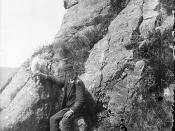The documentary film, by definition, is intended to "present facts objectively without the insertion of editorialization or fictional matter"ÃÂ (Collins 121). John Grierson argues this to be untrue. Grierson rather, refers to a documentary as the "creative treatment of actuality"ÃÂ (Winston 3). It would be impossible to create anything completely objectively. The moment that a director of a documentary film stands behind the camera, he or she is placing his or her thoughts, beliefs, and attitudes directly into the film. Documentary films are subjective through the film's styles and structures. Project Grizzly (Lynch) and Lonely Boy (Kroiter and Koenig) provide excellent illustrations of documentaries which use soundtrack, direction, editing, dialogue, and many other elements to "ÃÂcreatively treat actuality'. I will examine three of these formal components: direction, editing, and soundtrack. Much can be said for what a filmmaker is attempting to convey in their film through the techniques chosen and their function.
It is apparent that the directors of Lonely Boy appear to be attempting to deliver a depiction of Anka in which he is flawless. The opposite is true for the director of Project Grizzly. Lynch seems to be portraying the star as a hopeless clown with a hopeless cause.
The notion of the direction of a documentary is obviously problematic. Based on the definition of the documentary film, it seems paradoxical to have any direction of the content whatsoever. However, direction by a filmmaker is essential in the creative process of any film, including documentaries. Examples of blatant direction in the aforementioned films are not only plentiful but also critical. They shape the reality of the actual content of the film and place a spin on the presentation itself. Lonely Boy depicts Paul playing a show at the Copacabana Club and charming the crowd with his voice...


![[Portrait of Les Paul, Fat Tuesday, New York, N.Y., ca. 1980s] (LOC)](https://s.writework.com/uploads/3/31608/portrait-les-paul-fat-tuesday-new-york-n-y-ca-1980s-loc-thumb.jpg)